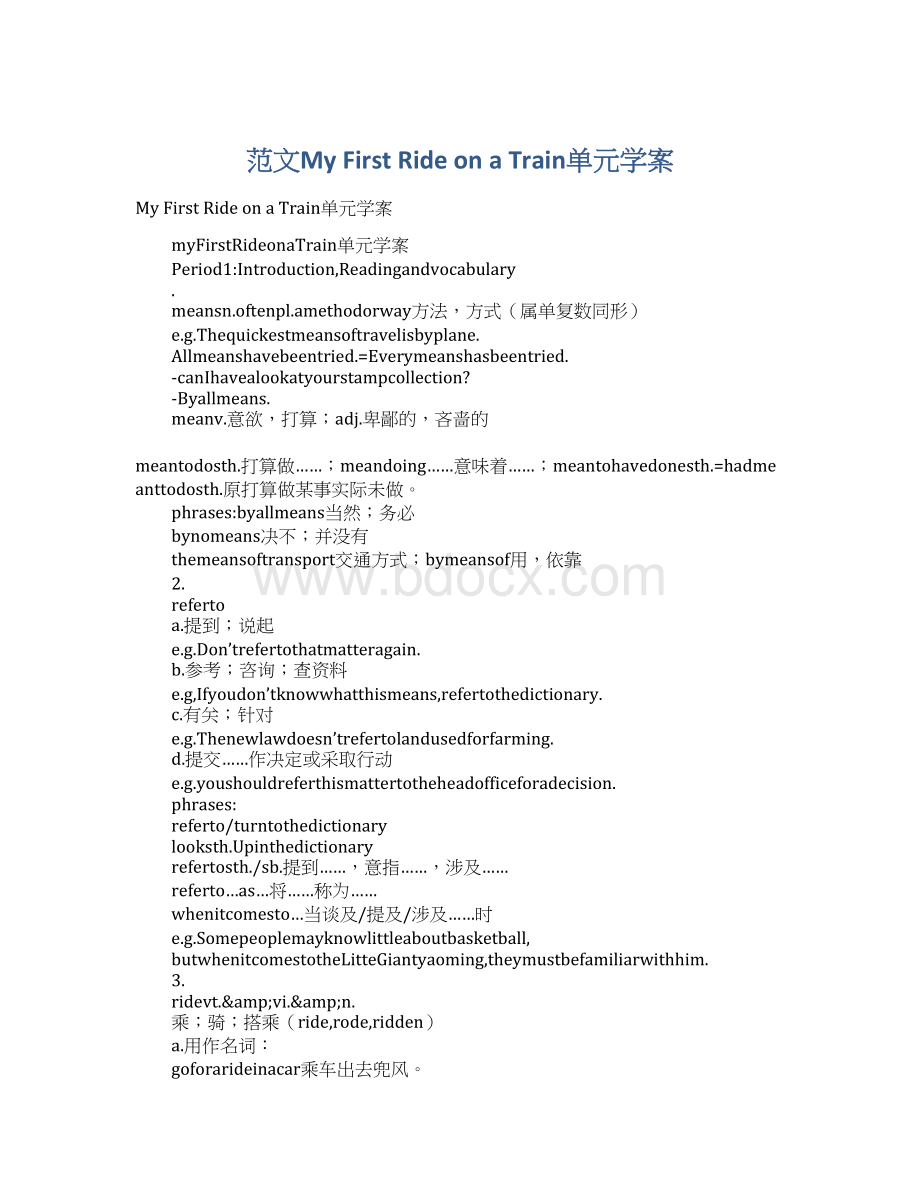范文My First Ride on a Train单元学案.docx
《范文My First Ride on a Train单元学案.docx》由会员分享,可在线阅读,更多相关《范文My First Ride on a Train单元学案.docx(10页珍藏版)》请在冰豆网上搜索。

范文MyFirstRideonaTrain单元学案
MyFirstRideonaTrain单元学案
myFirstRideonaTrain单元学案
Period1:
Introduction,Readingandvocabulary
.
meansn.oftenpl.amethodorway方法,方式(属单复数同形)
e.g.Thequickestmeansoftravelisbyplane.
Allmeanshavebeentried.=Everymeanshasbeentried.
-canIhavealookatyourstampcollection?
-Byallmeans.
meanv.意欲,打算;adj.卑鄙的,吝啬的
meantodosth.打算做……;meandoing……意味着……;meantohavedonesth.=hadmeanttodosth.原打算做某事实际未做。
phrases:
byallmeans当然;务必
bynomeans决不;并没有
themeansoftransport交通方式;bymeansof用,依靠
2.
referto
a.提到;说起
e.g.Don’trefertothatmatteragain.
b.参考;咨询;查资料
e.g,Ifyoudon’tknowwhatthismeans,refertothedictionary.
c.有关;针对
e.g.Thenewlawdoesn’trefertolandusedforfarming.
d.提交……作决定或采取行动
e.g.youshouldreferthismattertotheheadofficeforadecision.
phrases:
referto/turntothedictionary
looksth.Upinthedictionary
refertosth./sb.提到……,意指……,涉及……
referto…as…将……称为……
whenitcomesto…当谈及/提及/涉及……时
e.g.Somepeoplemayknowlittleaboutbasketball,
butwhenitcomestotheLitteGiantyaoming,theymustbefamiliarwithhim.
3.
ridevt.&vi.&n.
乘;骑;搭乘(ride,rode,ridden)
a.用作名词:
goforarideinacar乘车出去兜风。
canIhave/takearideonyourbike?
我可以骑你的自行车吗?
whataride!
多棒的旅程啊!
b.vt.&vi.
Hejumpedonhishorseandrodeaway.
canyourideahorse?
注:
ride用于骑马、骑自行车时,常用作vt.,
即rideahorse;rideabike;用于乘公共汽车时、乘火车时,常用作vi.,即rideonabus;rideonatrain.
4.
drivevt.&vi.驾驶;用车送;驱赶;迫使;飞跑;猛冲
drive表示“驱使,迫使”,后面接宾补(todo;adj.;adv;prep.phra.不用现在分词)
phrase:
drivesb.mad.使某人发疯;driveoff/out赶走;drivesb.away把某人赶走;drivesb.intoacorner逼得某人走投无路
ride/drive
ride-乘。
可以乘车辆,也可以乘其他工具(如马、自行车等);指车辆时,是乘车而不是开车。
drive-驾驶,驱赶。
宾语为车辆时,意为“驾驶”,是别的东西时,意为“驱赶”。
当两者用作名词,表示一段车程时无区别,如:
anhour’sride=anhour’sdirve
5.
distance
a.
c.n.&u.n.距离;间距
b.
c.n.&u.n远方;远处
c.
u.n.
d.
u.n.(人际关系的)冷淡,疏远
e.g.Agoodcyclistcancoverdistancesofoverahundredmilesaday.
Atadistanceofsixmilesyoucan’tseemuch.
Distanceisnoproblemwithmoderntelecommuciations.
phrases:
inthedistance在远处;在远方
fromthedistance由远处
atadistance在稍远处,在一定距离处
keepone’sdistancefromsb./sth.与某人/某物保持一定的距离
keepsb.atadistance
与某人保持一定距离
distancelearning远程教育
distantadj.遥远的
Period2:
Reading
.Getoff下车
a.getoff(使某人)出发
b.getoffsth.下班;不再讨论某事
c.getsth.off
邮寄某物;从某物上移去某物
e.g.wegotoffimmediatelyafterbreakfast.
Herfingerwassoswollenthatshecouldn’tgettheringoff.
Iusuallygetoffat6:
00p.m..
Phrases:
geton
上车getaround传播
getaway
逃离,离开办
getover
爬过,克服;熬过
getin
进入;收获;收(税等);getrideof除掉,摆脱getthrough通过;做完;看完
getup
起床,起身
getalong/onwith
进行;进展;与……相处getacross使……通过,(使)被理解
2.morethan:
over超过;仅仅
e.g.judgingfromhisappearance,heismorethan40.
notmorethan
与nomorethan
notmorethan不超过,顶多,相当于≤;nomorethan仅仅,只有,相当于=。
otherphrases:
more…than…与其说……倒不如说……e.g.He’smoremadthanstupid.说他笨,不如说他疯了。
nomore…than…与……同样不……(表示前后比较对象程度相当)
themore…,themore…越……就越……
moreorless或多或少
3.scenery,scene,view
Scenery-为自然风景的全称,常用来描述静态的乡村景色/
e.g.Thesceneryofthecountryisnotbeautiful.
scene-指某一特定环境呈现的景色,多半包含人的动作。
e.g.ahappysceneofchildrenplayinginthegarden.
View-属scenery的一部分,也就是从某处所见的情景。
e.g.There’snoviewfrommybedroomwindowexceptforsomefactorychimneys.
4.Afterthat,…..
that常“承上”;this常“启下的”
e.g.That’stheendofthenews.
Thereasonisthis.理由如下。
5.beshortfor为……的缩写;inshort简言之,总之
e.g.PRcisshortforthePeople’sRepublicofchina.
mynameisjohnson,butmyclassmatesalwayscallmejohninshort.
phrases:
beshortof=lack
缺乏……;短少;tobeshort简单地说,简言之
goshort欠缺,缺少
cut…short
使……中断,打断,阻止runshort
(物品)不足,短缺
6.not…anymore=nomore;not…anylonger=nolonger
not…anymore=nomore表动作不再重复出现或做某事的次数不再增加,多与瞬间动词连用。
E.g.youwillnotseehimanymore.
not…anylonger=nolonger表动作不再延续或时间上不再延长,多与延续性动词连用。
e.g.Shedoesn’tlivehereanylonger.
6.
the1920s20世纪20年代
请注意时间表达法:
the1830s19世纪30年代
the60s60年代
inher80s在(她)八十多岁的时候
otherphrases:
comefrom
onatrain
inthemiddleof
greatmealscookedbyexperts
looklike
Lookoutof
atmidnight
trydoing
trainedcamels
allowsb.todosth.
Period3:
Grammar1&2,Function,culturecorner
1.The–edform过去分词作定语
分词是动词的一种非限定形式,主要起构成形容词和副词的作用,共有两种形式,一种是现在分词(-ing),一种是过去分词(-ed).现在分词一般有主动的意思,过去分词一般有被动和完成的意思,以下主要是过去分词作定语的几点用法。
(1)及物动词的过去分词单独用作定语,表被动。
e.g.movedstudents
drownedpeople
usedpaper
abrokencup
developedcountries
个别的过去分词(多由不及物动词构成)只表示完成,不表示被动。
e.g.fallenleaves./returnedstudents.归国留学生。
某些动词的过去分词作定语,既可作前置定语,又可作后置定语,但含义不同。
e.g.Themethodusedisveryefficient./Thisisaused(用过的)book.
ThebookgiventohimisanEnglishnovel.
wewillbemeetingatagiventimeandplace.
有些过去分词己经失去了被动意义,相当于形容词作定语,表示主语所处的一种状态.常用来修饰人。
也可以修饰物,这类被过去分词所修饰指物的名词大概有两类:
a.指人发出的声音:
voice,shout,scream,cry等;
b.指人的面部表情:
face,look,expression,smile等;
修饰的过去分词有:
disappointed,puzzled,surprised,excited,satisfied,frightened,pleased,trembled,discouraged,etc.
afrightenedlook
惊恐的神态
afrighteninglook
吓人的神态